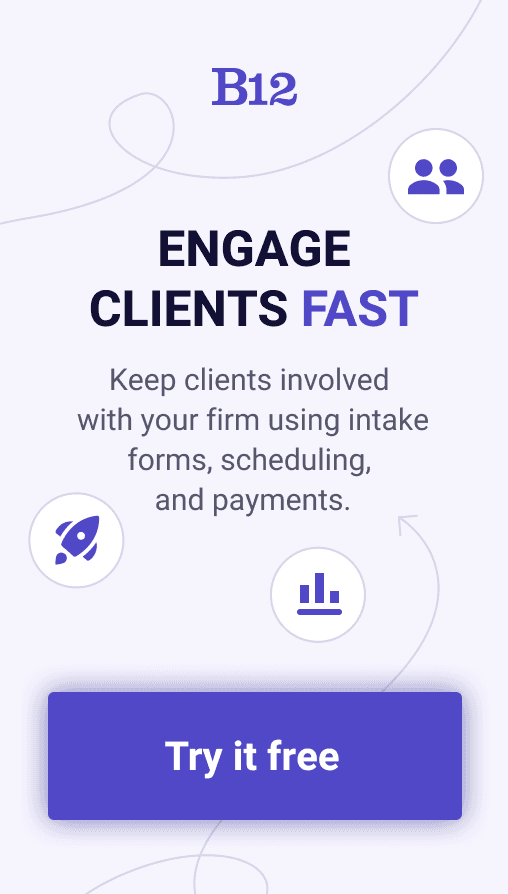Build an AI website in 60 seconds
AI generates your personalized website instantly with built-in scheduling, payments, email marketing, and more.
Start for free
Ways to reduce back-and-forth emails

One of the most often used forms of communication in the corporate sector is email. However, because email communication is so convenient, it's also usual for people to get caught in lengthy email threads that drag on interminably. It can feel like a never-ending cycle, consuming much time and energy. This blog post is especially for you if this sounds similar.
To save time and enhance teamwork, we'll look at several techniques to make email communication more successful and efficient in this post. Here are some tips to help you streamline your email and overall communication approach.
Why is emailing back and forth bad?
Email remains one of the most effective and practical ways to communicate, despite the rise of new communication platforms. Emailing back and forth, however, may rapidly become time-consuming, annoying, and ineffective.
Excessive emailing can create more problems than solutions. At its worst, it can result in misconceptions, miscommunication, and other problems that can impede business expansion. When too much time is spent on email exchanges, it's easy to lose sight of essential tasks and goals, causing delays and potentially stalling projects.
Furthermore, switching between email and other tasks can disrupt workflow and decrease productivity. High email volumes can be difficult to manage and can divert your attention from other crucial business tasks. You're merely responding to an onslaught of messages in your inbox rather than accomplishing anything.
In some instances, replying to emails can create more emails. A lack of clarity or direction can lead to several follow-up emails clarifying initially unclear points. Alternatively, emails often need to be more understood, further widening the communication gap, and leading to an influx of messages attempting to iron out issues. Excessive emailing can become a vicious cycle that stalls progress and negatively affects the business.
What are the ways to reduce back-and-forth emails?
Prioritize clarity in your initial email
It is essential to prioritize clarity in your initial email. This means that you must take the time to consider your exact words and delivery before speaking. Consider breaking down any complex ideas into smaller, more manageable pieces, and avoid using overly technical language. In addition, there is no harm in asking questions or for clarification; this can save you time in the long run by avoiding back-and-forth emails.
When you prioritize clarity in your email, it not only aids in better communication but also shows respect for the receiver's time. As a sender, you must ensure that your message is easy to understand and consider that the email's receiver may have little or no context on the topic discussed. Thus, keeping your communication clear and concise will enable the recipient to understand the email's objective better, reducing the possibility of confusion and the need for further correspondence.
In summary, clear and concise communication is key to avoiding the email back-and-forth trap that can slow down productivity. Prioritizing clarity in the initial email keeps communication crisp and concise, effectively leading to better utilization of both parties' time.
Embrace collaboration tools and project management platforms
Tools like Slack, Microsoft Teams, and Google Workspace make sharing files easy, collaborating in real-time, and staying up-to-date on important projects or initiatives. They also allow you to maintain a detailed record of your interactions and conversations, which can be particularly helpful when referring to previous discussions or decisions. This way, everyone can access the same information and stay informed without wading through a sea of email chains.
Similarly, project management platforms like Asana, Trello, and Monday.com are great for keeping track of timelines, deadlines, and progress. With the aid of these tools, it is simple to assign duties, establish deadlines, and keep track of development in real-time, ensuring that nobody is left in the dark regarding what they should be doing or how far along a project is. Again, it is beneficial to ensure that everyone is on the same page so that everything continues on course and is completed on time.
It's worth noting that only some teams will need or benefit from using every collaboration or project management tool out there. To decide what will be most beneficial and useful for you, evaluate the special requirements and work processes of your team. Start small and try out various tool combinations until you find the one that works for everyone. Feel free to experiment and explore what works best to streamline your communications process and allow everyone to collaborate more successfully.
Consider scheduling a call or meeting
Scheduling a call or meeting helps save time and provide clarity. It can help get everyone on the same page and clarify concerns that may not have been clear in email conversations. Additionally, it can help ensure that expectations are set and that deadlines are agreed upon.
It's important to consider which communication medium best suits your discussion needs. Opt for a quick call if it's a simple matter that can be resolved in minutes. However, it may be better to schedule a meeting if it's a more complex matter that requires deep collaboration and brainstorming.
Prepare for the call or meeting beforehand to make the most of it. Have a detailed agenda, prepare relevant notes or documents, and ensure everyone invited to attend knows the context and objectives of the call or meeting. In this manner, the conversation may be narrowed down, and everyone can leave the call or meeting knowing exactly what needs to be done next.
Avoid replying with just “thanks” or “ok”
One common mistake when emailing is replying with just one-word responses such as “Thanks" or "Ok." While this may seem polite, it can cause more confusion and create more emails back and forth. It can also be interpreted as dismissive or uninterested in the conversation.
Instead, ensure your response adds value or contributes to the discussion. If you have nothing to contribute, simply acknowledge receipt of the message and inform the sender that a more thorough response will follow.
This straightforward strategy might help you and your coworkers save time and irritation by streamlining your email exchanges. It’s important to take the time to read through messages carefully and respond thoughtfully to move the conversation forward.
By avoiding dismissive or one-word responses, you’ll be able to maintain a more productive and collaborative work environment. This can result in better project outcomes, improved relationships with colleagues, and greater job satisfaction overall.
Reducing back-and-forth emails is worthwhile
Email may be time-consuming and inefficient, resulting in a backlog of unopened messages in our inboxes. Embracing the tips mentioned makes it possible to streamline communication and maximize productivity.
Since the opening email is usually the foundation for any conversation, ensure it is clear and well-written. Summarize the main points you want to convey so that your recipient understands the purpose behind your message. This helps minimize the chances of back-and-forth emailing, which can slow the conversation and consume precious time.
Additionally, embrace collaboration tools and project management platforms to enhance communication between you and your coworkers. These tools allow for real-time communication and provide a centralized location for project update sharing. It's easy to start by signing up for popular project management tools used by companies such as Asana and Trello, which have user-friendly interfaces and built-in productivity features.
Consider scheduling a call or meeting on Skype or Google Meet. Direct communication channels offer an alternative to email, eliminating the back-and-forth emailing that can occupy a considerable part of your conversation. Scheduling a call or a meeting ensures that you can address all your issues in one go, saving time and boosting the pace of your project.
It's imperative to avoid concluding your discussion with a monosyllabic response of only "thanks" or "ok." It's customary etiquette to express gratitude to the person on the other end of the line. However, ending with only "thanks" does not provide additional input, which can contribute to confusion and extra communication. Instead, end with a complete statement or suggestion that advances the conversation.
In conclusion, streamlined communication is essential for effective team collaboration. By following these communication hacks, it's possible to improve group productivity and minimize potential disruptions to your workflow.
Manage your emails better with B12
With B12’s client engagement tools, you can communicate with your clients more clearly and efficiently! Easily use automated reminder emails and confirmations about payments and appointments to reduce back-and-forth communciation and eliminate uncertainty.
In addition, if you need a professional online presence for your business, B12 is the all-in-one solution that integrates a website, email marketing, online payments, and more Try B12 today to get a website built by AI and refined by expert designers, copywriters, and SEO specialists.
Make DIY changes any time you want or request help from experts. Launch in 30 days or less with client-engaging tools like scheduling and payments.
Attract, win, and serve more clients
Receive helpful resources directly to your inbox to help you succeed online.
Draft your site in 60 seconds
Get an AI website made specifically for you that's free to launch.
Start for free ✨No credit card required
Spend less time on your website and more time growing your business
Let B12 set up your professional online presence with everything you need to attract, win, and serve clients.





